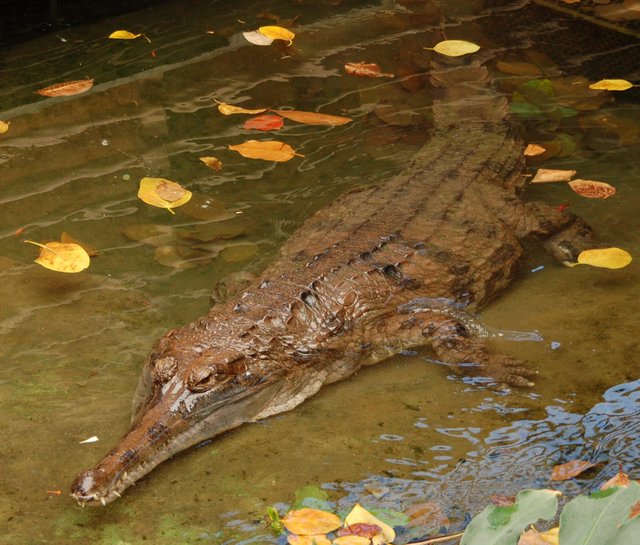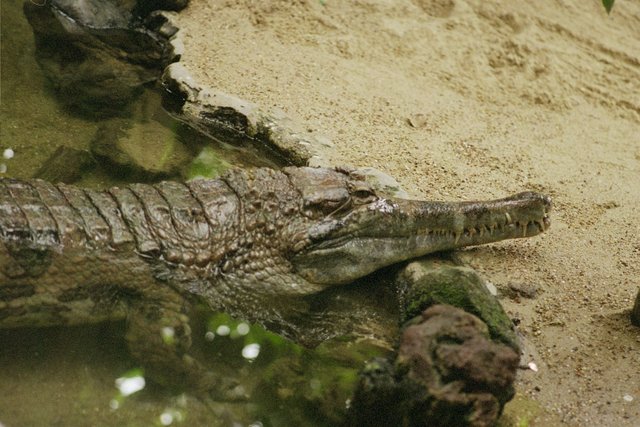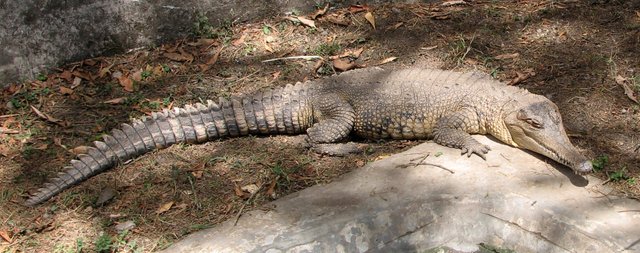A new species of crocodile has been described for the first time in over 80 years!
Even though some taxonomists believe that we have only described less than 10 % of all the species in the world, it's not an everyday occurrence that we get a new species of a large animal. When this happens, it tends to be because the animal has been hiding in plain sight, and this is pretty much the story of how we got a new species of crocodile, the first new crocodile species described since 1935!
The crocodile in question is found in Africa, and has been hiding as part of another species until now. It has been proposed the name Central African slender-snouted crocodile (Mecistops leptorhynchus), and until now no one knew that this species was different from the West African slender-snouted crocodile (Mecistops cataphractus), which used to just be called "African slender-snouted" until it got separated into two species.

A West African slender-snouted crocodile. It surely lives up to the name "slender-snote" in my opinion. Photo by Faux Gavial, posted with the Creative Commons Attribution 2.0 Generic license.
Both species of crocodiles are considered "medium length", but that still allows grown males to reach over 4 meters in length. They feed primarily on fish, which is why they have evolved to have a very long snout. This snout makes them easily distinguishable from other crocodile species.
You can find these crocodiles in tropical rainforests along the shores of very shallow rivers. They prefer freshwater, but they have also been found in brackish estuaries. They are notoriously difficult to find in the wild, not only because they are few in number, but also because they tend to be both shy and have good camouflage both in the river and on land. They are apparently very difficult to study, so we don't know a whole lot about the wild behavior of either of the two species right now, but we've learned a lot of them by keeping them on zoos and private collections.
Despite being in zoos and on farms (where they are bred for crocodile leather), no one had really paid much attention to the different varieties of the African slender-snouted crocodiles until now, when a research group from Florida International University spent several years looking at it.
How researchers found the crocodiles to be two separate species
The research group who identified them to be two separate species began their work several years back, and published the first paper with proposal to change the species into two species back in 2013 with the paper "Rigorous approaches to species delimitation have significant implications for African crocodilian systematics and conservation". This paper was the groundwork for the newly published "Systematic revision of the living African Slender-snouted Crocodiles (Mecistops Gray, 1844)" that actually solidified the claims that it should be divided into two species.

Photo is Public Domain.
The original 2013 paper used genetic testing on over 100 individuals to see how different they were, and categorized them into groups based on how much genetic material they shared. While this paper provides a good indication that this crocodile might not only be a single species, it took them another 5 years to publish a taxonomic revision proposal, which was just accepted by the journal Zootaxa a week ago.
Taxonomy can be a difficult research field to navigate at times, but this newly published paper should likely set an end to the debate and uncertainty of the status of the crocodiles. The differences combined with fossil-calibrated phylogenetic reconstructions estimated that these two actually separated from each other between 6.5 and 7.5 million years ago, so it's not like they are "new species" by evolutionary standards. Their genetic difference is over 5 %, which is just a little bit more than the difference between humans and chimpanzee.
There is also a small morphological difference, and the Central African slender-snouted crocodile has a softer, smoother appearance compared to the Western species. The latter one also has heavier scales, rougher skin, and lack a bony crest on the skull that is found on the Central African slender-snouted crocodile.

A Central African slender-snouted crocodile. Photo by Wikimedia Commons user Leyo, posted with the Creative Commons Attribution-Share Alike 2.5 Switzerland license.
The consequences of having two species instead of one
I know that some of you might be wondering "why should I care?" right now, and I can understand that. It's not like everyone loves reading about taxonomy, but let me tell you, there is a big real-life consequence of it being divided into two species!
With information that makes these crocodiles two species, we now have to create new conservation strategies that ensures that both species will survive. The old African slender-snouted crocodile was already considered Critically Endangered by the IUCN Red List, with estimations of only having 1,000 to 20,000 individuals left in the wild. This is of course a big problem, but the West African slender-snouted crocodile could have as few as 500 individuals left! This put it right on the brink of extinction, and this new change should hopefully spark some serious efforts into preserving it as soon as possible. If not, we might soon go back to only having one species of African slender-snouted crocodiles..
The current range of where the two crocodile species are found. It's a huge area for very few animals, which makes them difficult to find. Map is generated by IUCN.
Sources
- Shirley, M.H. et al. 2018. Systematic revision of the living African Slender-snouted Crocodiles (Mecistops Gray, 1844), DOI: http://dx.doi.org/10.11646/zootaxa.4504.2.1
- Shirley, M.H. et al. 2013. Rigorous approaches to species delimitation have significant implications for African crocodilian systematics and conservation, DOI: http://dx.doi.org/10.1098/rspb.2013.2483
- "New crocodile species found hiding in plain sight" by Douglas Main, published in National Geographic.
- Shirley, M.H. 2014. Mecistops cataphractus. The IUCN Red List of Threatened Species 2014: e.T5660A3044332. http://dx.doi.org/10.2305/IUCN.UK.2014-1.RLTS.T5660A3044332.en. Downloaded on 03 November 2018.
- "Mecistops cataphractusAfrican slender-snouted crocodile" by Joel Lavinder and Joshua Pennington, published in Animal Diversity Web.
Thanks for reading!
I hope you enjoyed learning about how the African slender-snouted crocodile is now divided into two species, as well as learning about the extinction threat they are facing (if you can even enjoy that). Thanks for stopping by, and feel free to comment below with any questions or other comments! I appreciate all constructive criticism, so let me know what you think.
This post has been voted on by the SteemSTEM curation team and voting trail in collaboration with @utopian-io and @curie.
If you appreciate the work we are doing then consider voting all three projects for witness by selecting stem.witness, utopian-io and curie!
For additional information please join us on the SteemSTEM discord and to get to know the rest of the community!
Hello @valth, there are more to discover in Africa especially on wildlife, to be sincere!
Thanks for this post. Please I like exposures like this, I love nature and would love to see more from you.
I’m still a friend @maxdevalue
Yep, Africa sure has lots of different things that are worth checking out, other than just crocodiles :)
I'm glad you liked the post, @maxdevalue!
That is interesting to read. In fact, it is more the division of a class of animals into 2 instead of the discovery of a totally new species. Just one naive question: how large should be the differences in genetic material before we would divide a specific into 2?
Yes, I guess that's true. Maybe I was a bit too sensationalizing in the title?
Unfortunately there is no agreed-upon number that everyone accepts, so it's a bit fluid, and dependent on the species in question. There's also a big different between different organisms, so a number that might work for mammals might not be good to use for bacteria, plants, or invertebrates. Right now genetic material is only one of several factors that helps determine if organisms belong to the same species, subspecies, or just are geographical variations.
It will be interesting to see if everyone can find a number to agree upon in the future, but I doubt it. Biologists still haven't even agreed upon a definition for what is a species yet, so I don't think taxonomists will not lose their job to geneticists just yet!
I would be very happy to a number that varies from classes of animals to classes of animals. If a common ground to all animal species can't be found (I actually agree this may be tricky to find), let's just make it simple enough but allowing some tuning.
Me too! I really hope we get to that point in the future, but I guess we need a lot more genetic data before we can really begin to decide where to draw the line. But whole genome sequencing is getting cheaper by the year, so we will soon enough have more genetic data than we know what to do with.
Oh I love news like this! We usually tend to read the very opposite kind of news - that we lost (yet another) species. May the newly discovered croc flourish and reproduce well :) Thanks for sharing that with us @valth.
Yep, it tend to be a lot of negative news when it comes to conservation biology and biodiversity sciences, so good news like this one is nice to write about :) And I hope they it will thrive as well, but it's in a very bad position already, since there are so few individuals.
Crocodiles are famed to have ancestory that leads back to the time of dinosaurs, i think this is a great discovery and there will still be more species out there to discover.
Yep, that's true! I'm sure there are lots of other species out there, but this might have been the last new species of crocodile that we find in a while.
Great, that's what I call good news, because crocodiles were my favorite animals since I was a kid, so thanks for this Update. :)
You're welcome! Crocodiles are really cool and interesting animals, so I see why they were your favorite :)
It was nice knowing that we discovered (separated) a new specie in this recent times.
It's sad to hear that they are on the brink of extinction. Just hope effective measures will be taken to avert this.
Yep, I hope so as well. It would be sad if we can't save it :/
Congratulations @valth! You have completed the following achievement on the Steem blockchain and have been rewarded with new badge(s) :
Click here to view your Board of Honor
If you no longer want to receive notifications, reply to this comment with the word
STOPTo support your work, I also upvoted your post!
Do not miss the last post from @steemitboard:
Hi @valth!
Your post was upvoted by Utopian.io in cooperation with @steemstem - supporting knowledge, innovation and technological advancement on the Steem Blockchain.
Contribute to Open Source with utopian.io
Learn how to contribute on our website and join the new open source economy.
Want to chat? Join the Utopian Community on Discord https://discord.gg/h52nFrV
Hi @valth!
Your post was upvoted by @steem-ua, new Steem dApp, using UserAuthority for algorithmic post curation!
Your UA account score is currently 5.182 which ranks you at #854 across all Steem accounts.
Your rank has improved 4 places in the last three days (old rank 858).
In our last Algorithmic Curation Round, consisting of 257 contributions, your post is ranked at #16.
Evaluation of your UA score:
Feel free to join our @steem-ua Discord server